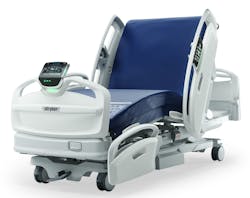Caring for the hospital’s workhorses that cradle patients
Ask the famous physiological trivia question, “What is the largest body organ?” and people likely may respond with the intestines or the lungs, completely missing the obvious answer: Skin. Same can be said for asking people what they think is perhaps the most important product (device, equipment, etc.) within a healthcare facility. Responses may veer toward surgical robotics, computed tomography (CT) scanners or magnetic resonance imaging (MRI) units, completely missing the obvious answer: Beds.
After all, where do inpatients – whether in critical care, surgery or patient rooms – spend the most time?
Steady, extensive use, of course, can lead to excessive wear-and-tear and breed infectious microorganisms – viral and bacterial – if the beds and their mattresses are not routinely and completely cleaned, decontaminated and disinfected or sterilized. Over time, beds and their mattresses will need to be replaced via recycling or even disposal if they’re too far gone to be repurposed in some way.
Because patients spend so much time in beds and on mattresses it stands to reason that healthcare organizations should have comprehensive maintenance, repair and replacement procedures for one of their most integral products.
Unfortunately, carrying out effective bed and mattress maintenance protocols is not necessarily the case for everyone. The obvious question is why? There’s a lot resting on that product.
Not so fast
Simple timing represents one of the principal impediments to thorough and proper maintenance, according to bed and mattress company executives.
High census rates mean few to no vacancies in patient rooms, according to a Stryker spokesperson who released an official statement to Healthcare Purchasing News.
“When a room does become available, hospital staff must clean, disinfect and change-out that entire room as quickly as possible in preparation for the next patient,” the Stryker spokesperson stated. “Beds and mattresses are often focal points for cleaning and disinfection, and there can be challenges because of their size and weight. Cleaning products can require up to three minutes, in most cases, to properly disinfect and sanitize a surface, including Stryker’s beds and mattresses. Ensuring that wet mattresses are not put back onto a bed frame, which can lead to rusting and/or premature breakdown of components, is critical to realizing full useful life.”
Census contributes to infrequent access to beds and mattresses as well, according to Stryker’s spokesperson.
“When a problem arises on a bed or mattress, or an annual preventive maintenance inspection is due, the bed must be temporarily taken out of service,” the spokesperson stated. “If the hospital facility does not have extra beds available to swap out, an entire room can potentially be unavailable until all required work is complete.”
“Some of the most prevalent are rushing protocols due to time constraints, lack of correct training and education, lack of communication, staff turnover and at times use of inferior products or not following [manufacturer instructions for use] due to their complexity,” Willoughby told HPN. “Out of these contributors, I would say that time constraint and inconsistent protocol implementation resulting from lack of correct training and education are key contributors.”
Linet Americas’ Aitken also acknowledges education as a factor.
“In most areas of the hospital, turnover is an issue, and staff need to be trained to inspect mattresses properly,” he advised. “This education also extends to the management level, who needs to understand not only the cost avoidance that can be achieved by utilizing a robust inspection program, but also the impact of improper cleaning on the spread of infection in the hospital and health of patients.”
Solid mattress covers can extend the product’s life but even those can be damaged by other cleaning and clinical products, according to Surface Medical’s Lam.
“Because they are in constant use, hospital mattress covers are frequently damaged by sharp objects and by the caustic cleaning agents used during routine disinfection and terminal cleaning,” he noted. “If they are not properly maintained, hospital mattresses can become reservoirs of deadly pathogens, leading to the possible spread of hospital-associated infections (HAIs) to patients and staff.”
Consequently, Lam emphasizes the need for routine awareness of mattress cover intactness for infection prevention as tantamount to any maintenance program.
“A mattress is usually concealed by bed linens, so damage tends to escape notice by hospital staff until it is cleaned between patients,” he indicated. “This scenario is problematic, however, because staff may not want to risk removing a much-needed mattress from service while a replacement mattress is sourced. Sadly, this means minor damage such as rips or punctures are often overlooked until they become too big to ignore, but even a small puncture can allow pathogens to enter the mattress core and render the equipment ‘uncleanable,’ putting patients and staff at risk of contracting an HAI. The US FDA has received hundreds of reports of patients that have [been attributed to] a damaged mattress soaked with blood or other bodily fluids.”
“Patients’ contact with gowns and bed linens make it imperative that every healthcare facility properly handle and maintain the cleanliness of these healthcare textiles,” she urged. “Research shows that environmental contamination can lead to infectious disease outbreaks in hospitals, and therefore, every surface these linens encounter must be carefully inspected.”
TRSA members launder an estimated 90 percent of North American hospital linen volume, and many follow the standards of the association’s “Hygienically Clean Healthcare” certification, which is verified by independent third-party inspections and microbial testing, according to Ketevong.
“Pathogens can exist on surfaces for hours or even months, making safe handling procedures critical from transportation to storage and distribution, ensuring [healthcare textiles] remain as clean as when they were laundered,” she cautioned. “Linens should remain covered and a physical separation of clean and soiled [healthcare textiles] should always be maintained. Clean [healthcare textiles] must be properly stored, ideally in a designated clean holding room, away from all possible contaminants, on organized and labeled shelves. Upon distribution, healthcare staff need to be mindful of keeping the [healthcare textiles] away from potentially contaminated surfaces and uniforms.”
Stryker encourages “proper and regular maintenance” of beds and mattresses to optimize performance, even if such oversight must be conducted by an external third party service provider, including the original equipment manufacturer (OEM).
“It is rare to have an experienced and dedicated bed repair technician in a hospital’s BioMed department, and thus beds and mattresses are often low on the priority list,” the Stryker spokesperson stated. “This is especially true because of the criticality of the other equipment needing attention or if spare beds are available. Therefore, partnering with an OEM repair service allows for regular maintenance inspections and is like having an in-house expert bed technician at your request.”
It's so easy
Bed and mattress company executives recognize how easy it can be to miss or neglect proper and thorough maintenance of these products.
“When a visual inspection fails to detect micro damage, when cover permeability testing or support surface evaluation are not conducted when needed, or when ineffective manual cleaning occurs at time of termination any failure of these processes is still, unfortunately, a reflection of how underappreciated these risks pose to not to only patients and staff but to visitors as well,” lamented Medtrica’s Willoughby.
Aitken from Linet Americas zeroes in on the mindset of taking something for granted.
“Mattresses have the out-of-sight, out-of-mind issue,” he noted. “They are almost always hidden from view by the sheets and are not considered a medical device that needs proper maintenance and inspection.”
But he also singles out the number and variation of staff involved.
“Multiple departments seem responsible for the mattress,” he observed. “Housekeeping for cleaning and disinfection, nursing staff for its clinical suitability and biomedical for its control in the case of an active surface. Historically there is often little to no coordination between these groups regarding mattress maintenance.”
“The inability to gain access to the beds and mattresses can also lead to missing proper maintenance,” the spokesperson continued. “Communication with floor staff, such as Nursing, [Environmental Services] and Transport team members is key to success in this area.”
Surface Medical’s Lam warns against overlooking the importance of intact treatment surfaces for patient safety.
“Without routine inspection protocols in place, a nurse or environmental services staff might not identify infection risks such as fluid ingress due to a minor puncture,” he said. “It is important for a hospital to proactively look for and address damage to ensure patient surfaces are intact and cleanable, rather than waiting until the damage is too big to ignore or fluid ingress has already occurred.”
TRSA’s Ketevong expresses concern about a healthcare organization’s internal procedures and standards for preserving clean linen once delivered from a TRSA-certified supplier, homing in on guidelines from The Centers for Disease Control and Epidemiology (CDC) that she says may be “very limited and not clearly defined.”
She cites CDC guidelines as stating, “‘hygienic and common-sense storage and processing of clean textiles is recommended,’ With room for interpretation, this could mean something different for every facility or individual. Instead, having clear and concise rules and regulations would limit the margin of error and guarantee the safe storage and handling of clean [healthcare textiles],” she added.
Elevating priorities
Bed and mattress company executives concur that hospitals and other healthcare facilities must make product maintenance a higher priority across the board, which hinges on and stems from increased education.
Surface Medical’s Lam pinpoints three priorities: “Educating staff on the importance of intact treatment surfaces to HAI reduction, implementing a routine mattress inspection program and training staff to repair or replace a mattress when damage is identified.
“Most damage is repairable if it is identified early,” Lam continued, “so a proactive approach will allow hospitals to minimize the risks posed by compromised mattresses while reducing the budget required for equipment replacement. It will also help reduce citations from accreditation services such as The Joint Commission and increase the capacity of healthcare organizations to treat patients and, concomitantly, reduce revenue lost from removing beds from service while waiting for new equipment to arrive.”
Adhering to proper and thorough protocols “can allow for more satisfied end users, higher functionality of the products and less product downtime, which can lead to a better patient experience,” stated the Stryker spokesperson who also emphasized keeping diligent cleaning and maintenance records as required for accreditation.
Healthcare organizations certainly can implement their own detailed procedures, but they could start with OEM recommendations, according to Linet Americas’ Aitken.
“Each manufacturer has tested and developed a program to clean and inspect mattresses,” he said. “The financial impact [includes] details on how much the facility is spending on replacement mattresses, hospital-acquired Infections and hospital-acquired pressure Injuries – all of which are related to the condition of the mattress.”
TRSA’s Ketevong recommends keeping vigilant on textile protocols and standards, too, and think about sustainability practices.
“TRSA has estimated that healthcare facilities lose roughly $840 million each year primarily from items lost or discarded as waste when they could have been washed and reused,” she noted. “Studies, such as one conducted by the University of Michigan Health System, have found that units that follow a clear bed-changing policy generate less waste on average compared to units without such a policy.
“Establishing comprehensive [healthcare textile] storage and distribution practices will not only reduce the spread of infection and promote a culture of safety in healthcare settings, but it also can reduce costs by diminishing the expense of lost linen products,” she continued. “Healthcare providers may also wish to consider the balance of reusable linens versus disposable products in their bed and mattress maintenance planning. TRSA recommends maintaining an inventory of 50% reusable linens as a hedge against surges in demand, supply chain issues or other unanticipated disruptions that might prevent them from receiving regular shipments. By maintaining a 50% reusable stockpile, hospitals and clinics ensure continued availability of hygienic linens.”
All told, however, Aitken urges healthcare organizations to embrace a new approach and attitude about beds and mattresses.
“Begin treating the mattress as a medical device in the hospital,” he insisted. “The complexity and technology inside mattresses have been steadily evolving, and many in the hospital still see it as simply a thing under the patient.”
References
1. Best Practices for Cleansing, Disinfecting, and Care of Polyurethane Support Surface National Pressure Injury Advisory Panel. https://cdn.ymaws.com/npiap.com/resource/resmgr/s3i/S3i_NPIAP_Cleansing_Disinfec.pdf
2. Disinfecting hospital beds and mattresses: A time for change https://www.ajicjournal.org/article/S0196-6553(21)00511-3/fulltext
3. United States Food and Drug Administration Hospital Beds – Covers for Hospital Bed Mattresses: Learn How to Keep Them Safe. https://www.fda.gov/MedicalDevices/ProductsandMedicalProcedures/GeneralHospitalDevicesandSupplies/HospitalBeds/ucm585737.htm
4. Meyer J., Nippak P., Cumming A., An evaluation of cleaning practices at a teaching hospital. Am J Infect Control. 2021; 49: 40-43
Recommendations for bed and mattress maintenance, repair
How can and should healthcare organizations establish or improve their bed and mattress maintenance protocols? Five experts share their tips.
“Provide more frequent and more detailed, in-service education and training on proper inspection and cleaning/disinfecting. And implement an efficient, standardized (and auditable) inspection process with effective test protocols would help address these ongoing challenges.”
David Willoughby, vice president, Marketing & Business Development, Medtrica Solutions Ltd.
“Mattress covers are easily damaged due to the nature of the materials they are made from (polyurethane-coated fabric), and the rigors of daily clinical use. It is vitally important that healthcare organizations educate staff on the importance of intact treatment surfaces to disease prevention, so they understand the urgency of supporting a consistent mattress maintenance program and its role in reducing the spread of [hospital-associated infections].
“It is also important to train staff on what action to take when a damaged mattress cover is discovered. In the past, there was a tendency to ignore minor damage because the only available solution was to replace the entire mattress, which is a significant expense for a hospital with a limited mattress budget; and even when mattress replacement is a viable option, replacement can involve removing a bed from clinical use for several days or even weeks. There have, however, been recent technological breakthroughs that allow damaged soft surfaces such as mattress covers to be repaired quickly without removing the bed from service. The cost to repair a damaged mattress cover is a fraction of mattress replacement, so cost should not be a barrier to implementing a sustainable and affordable maintenance program.
“To best support a safe treatment environment for patients and a safe working environment for staff, hospitals can establish a routine mattress inspection and maintenance program so damage can be repaired proactively. There are many resources available to help hospitals develop such a program. For example, Surface Medical Inc. (www.cleanpatch.ca) offers a virtual training program on how to assess whether a damaged mattress cover meets the criteria for repair and, in 2018, The Joint Commission published a comprehensive document (Environmental Infection Prevention: Guidance for Continuously Maintaining a Safe Patient Care and Survey-ready Environment) on maintaining a clean treatment environment. There are also independent cleaning and preventive maintenance companies that provide audit and preventive maintenance services.
“Lastly, healthcare organizations need to provide training to all staff so they understand the importance of early detection, and staff must be equipped to identify and report damage. It is also important to work closely with manufacturers and service providers to ensure they have immediate access to repair or replacement products when needed.”
Iwain Lam, president and CEO, Surface Medical Inc.
“Implement an inspection program for the mattress every time it is cleaned. This will help catch problems before they can cause a larger issue. Small holes or wear can be addressed by having replacement covers readily available for housekeeping to replace before the mattress’s core has been contaminated, which cannot be disinfected or cleaned.
“Develop a preventive maintenance (PM) plan for surfaces the same way that other pieces of equipment are cared for in the hospital.
“[Add] a liner on the foam core mattresses, which protects the foam from fluid ingress if the cover is compromised.
“Always utilize a clear water rinse after the disinfection process. This is the most important part of the cleaning process and right behind the inspection process in importance to mattress longevity. Not only does the clear water rinse improve the fabric’s longevity, but it also reduces the incidence of contact dermatitis, which occurs when the cleaning chemicals left behind are rehydrated by the patients’ perspiration. There is a great deal of misinformation about the cleaning and disinfection of a mattress, especially around the use of a one-step disinfectant. These products are typically used on all parts of the rooms and bed, but not designed for one-step use on a soft surface.”
Andrew Aitken, director, Product Management and Marketing, Linet Americas
“Maintenance of beds and mattresses can be improved by partnering with an OEM supplier repair service, which can be readily available as a resource to the hospital. Partnering with [an OEM repair service] ensures that none of your contracted products experiences lengthy downtime and allows clinicians to focus on patient care.
“If your hospital has a BioMed department and/or a dedicated bed technician, it is imperative to follow the OEM specifications on maintenance and repairs. Prioritizing the service and maintenance of beds and mattresses will allow for a more optimal patient experience, and your staff will greatly appreciate having access to the equipment they need when they need it. To allow for more timely maintenance and response to potential repairs, having inventory of commonly serviced parts on hand can also result in time savings and decreased downtime of a bed or mattress.”
Stryker spokesperson
“Unfortunately, many things can go wrong throughout [healthcare textile] storage and distribution. Medical staff members must presume that anything [healthcare textiles] contact could be contaminated and take every sanitation precaution possible. Healthcare professionals must maintain good hand hygiene prior to distributing linens and avoid all contact between [healthcare textiles] and their uniforms to ward against the spread of infectious diseases.
While safeguarding the clean [healthcare textiles] delivered to a facility, it is also imperative to keep soiled linens separate. Contaminated linen should not be sorted or rinsed in the location of its use but rather transported to the laundry for decontamination. When handling soiled hospital linens, TRSA recommends following the ‘Six C’s’: Cover, Collect, Contain, Consolidate, Clean and Cooperate. (https://hygienicallyclean.org/hygienically-clean-healthcare/media-downloads/six-c-handling-clean-soiled-linen/)
“Healthcare facilities and hospitals must develop a written policies and procedures manual outlining their own best practices for handling [healthcare textiles.] These guides train new staff members and should be used for monitoring and evaluating linen handling.”
Samlane Ketevong, Senior Director of Certification, TRSA
About the Author
Rick Dana Barlow
Senior Editor
Rick Dana Barlow is Senior Editor for Healthcare Purchasing News, an Endeavor Business Media publication. He can be reached at [email protected].






